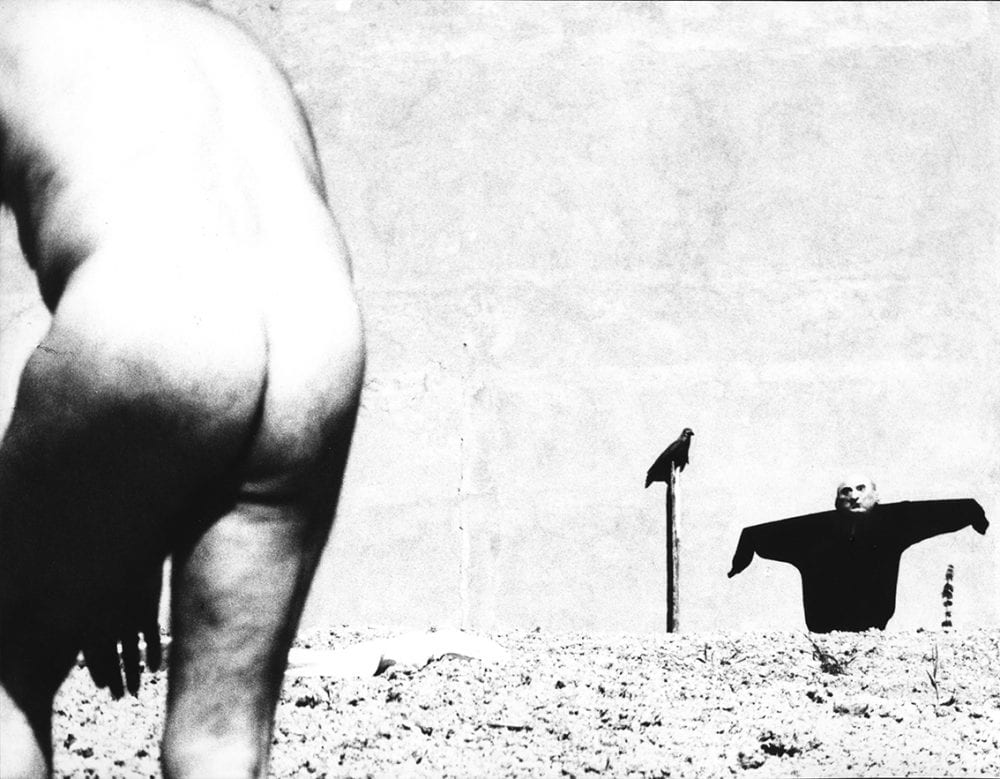The Hand
Written by Sama Moayeri
2020

Mario Giacomelli, Questo ricordo lo vorrei raccontare, 2000 © Mario Giacomelli
In a photograph from the series "Questo ricordo lo vorrei raccontare", Italian photographer Mario Giacomelli (1925–2000) presents us with a profound visual allegory, one that summons the dissonance of being itself. It is an image composed of three figures, each embodying an aspect of human vulnerability and existential displacement. A naked man, hunched and retreating toward some unknown goal, his face obscured, stands as a symbol of the dehumanized, faceless subject, an image of all of us in our rawest form, abandoned and enervated. His hands—lifeless, as though frozen in the moment of their creation—reach blindly through the earth, their desperate groping a futile echo of the human search for meaning, for purpose, for something to grasp. Far off in the distance, a scarecrow stands unmoving, a lonely sentinel in an empty landscape, while a raven, indifferent and without focus, observes the scene, as though aware of its own inevitable role in the cycle of death and decay. The man is a figure of absolute loss—an embodiment of the estranged human soul, fallen and fractured. He is the nameless, faceless everyman, rendered as a thing of flesh whose identity is swallowed by the forces that oppress him. The concrete wall that rises in place of the sky is a tombstone, a memorial to his obliterated potential, the final mark of a world in which he can no longer return to a state of grace or identity. There is no going back, no redemption. The search itself becomes an act of surrender, as the earth devours the last traces of hope. Yet, in this stark composition, the scarecrow and the crow emerge as figures whose roles transcend their immediate symbolic functions. In a fleeting moment of stillness, they cease to act out their prescribed roles of terror and foreboding. Instead, they become witnesses, absorbed by the tragic scene that unfolds before them: the lifeless, struggling body of man, desperately reaching for something that cannot be grasped. The scarecrow, more anthropomorphic in its construction than the man, seems to experience a brief flicker of consciousness. For a moment, it remembers its creator—perhaps in an attempt to make sense of its futile existence. But it is rooted, bound to its post, unable to move, trapped in a perpetual state of impotence. It is a hollow sentinel, one that can do nothing but stand guard over an empty land. Even the crow, a creature that symbolizes death and decay, is on a search of its own. It seeks something precious, something that would justify its presence in this desolate world—a thing worthy of its vigilance. And yet, in the context of this apocalyptic moment, what could that possibly be? Giacomelli’s genius lies in the way he weaves complexity from simplicity, constructing an allegorical network in which even the most minimal elements of the image become dense with meaning. The choice of a tightly framed shot, the economy of visual information, serves not merely to isolate these figures but to implicate them in a web of existential meaning. Here, the scarecrow, the raven, and the man are not just passive objects; they are active participants in a dance of imposed meaning—an unspoken argument between what is and what we insist must be. Through these relationships, Giacomelli forces us to confront the lie of meaning, the imposition of interpretation where none should exist. The raven’s implied thought—"There must be something," it seems to say—is the same thought that the man entertains, a thought that propels him to search for that illusory purpose: "There must be something to fight for." Giacomelli’s critique of existence and meaning is sharp, biting. He mocks the human compulsion to construct meaning from chaos, to impose purpose where there is none. The act of guarding these fabricated meanings, of clinging to the illusion of justification, becomes a farce. The existential dilemma, then, is not the loss of meaning, but the human tendency to cling fiercely to it, as though its absence would somehow obliterate the will to live. "What reason would there be to survive?" Giacomelli seems to ask. "What remains when meaning dissolves? What remains when the impulse to protect the imaginary is gone?" The bitter irony of Giacomelli’s work is evident in the displacement of roles and scales. What was once a practical function—the scarecrow’s role in protecting the harvest, the crow’s role as a harbinger of doom—becomes a meditation on futility and collapse. The human condition, laid bare in the image, is no longer a matter of survival but of recognition: recognizing the absurdity of existence, the impossibility of finding real meaning in a world that offers none. Through this displacement, Giacomelli freezes a moment of pure time—an absolute cessation of movement—and in doing so, captures the endless, cyclical nature of human existence: the relentless return to the same void, the same confrontation with our own futility. And in the final, haunting question—"Man, where is your other hand? Go search for it in the earth"—Giacomelli exposes the cruel paradox at the heart of human desire: the search for something that may not exist, the longing for meaning in a world that resists it, and the futile hope that somehow, somewhere, there is a reason for all of this.
Fair Use Notice: This website may contain copyrighted material used under the doctrine of Fair Use as outlined in Section 107 of the U.S. Copyright Act. Such material is made available for the purposes of commentary, critique, education, and scholarly research. All images and texts remain the property of their respective copyright holders. No copyright infringement is intended. If you are the rights holder and believe your work has been used improperly, please contact us to request removal or proper attribution.